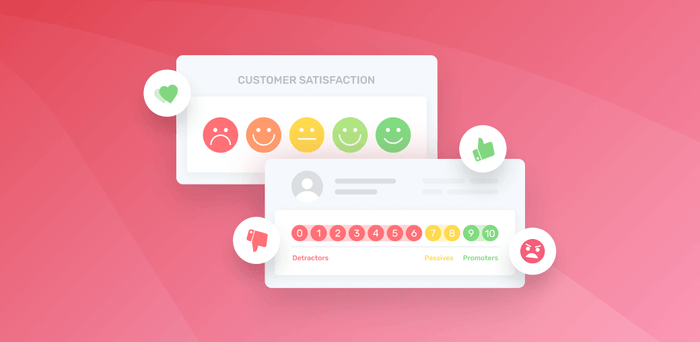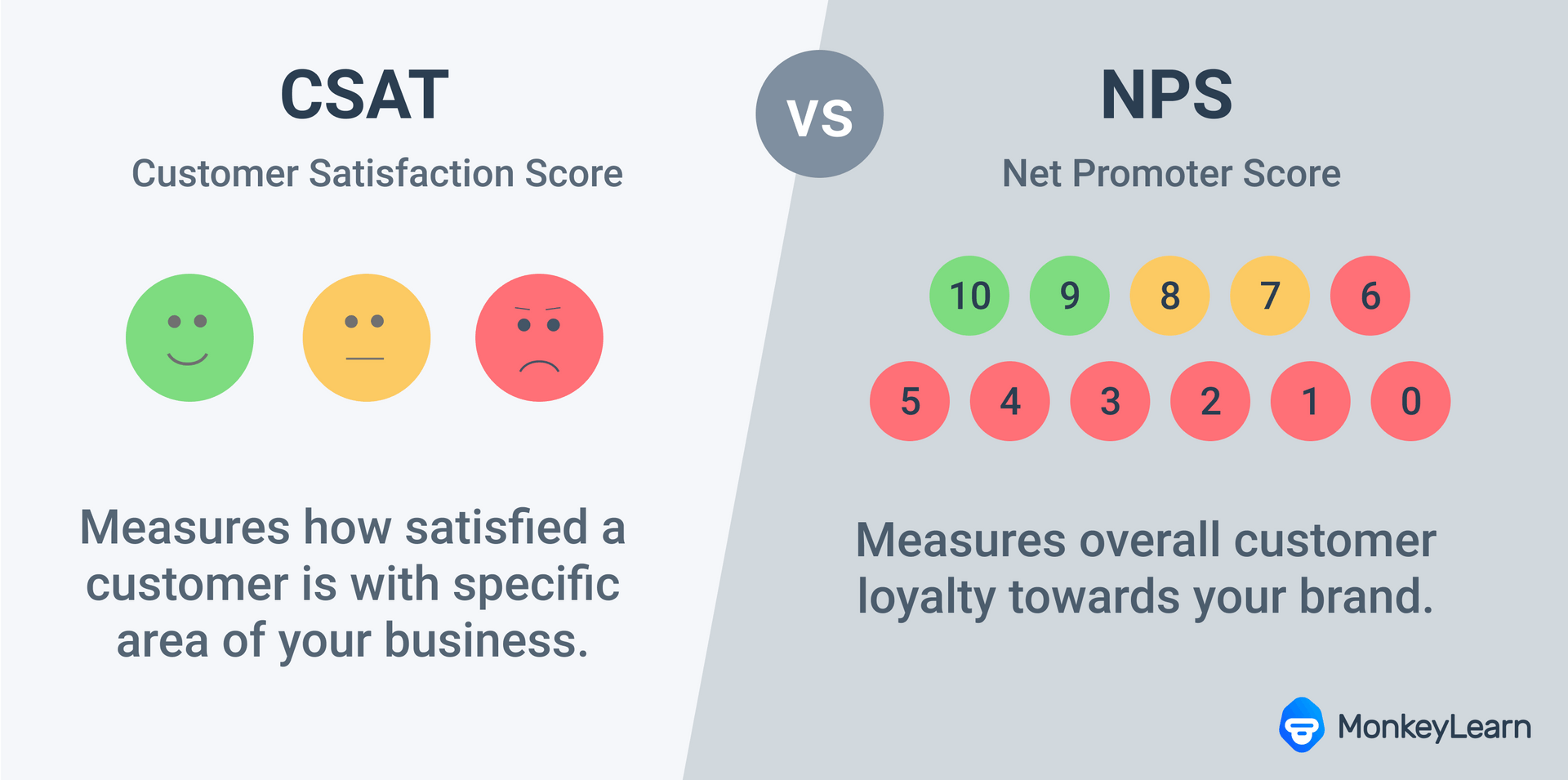CSAT vs NPS – Which Customer Satisfaction Metric Is Best?

Sending surveys allows you to keep a pulse on customer satisfaction. When you know how customers feel about your brand you can make strategic decisions to increase customer loyalty, retention, and – in the long run – drive more sales.
Businesses routinely send customer satisfaction (CSAT) and Net Promoter Score (NPS) surveys. Both types of survey contain a simple close-ended question to help businesses determine their satisfaction scores, as well as an open-ended question to understand the reasons behind each score.
But, each survey focuses on a different aspect of customer happiness.
Let’s start with a definition of a CSAT score and an NPS score, before diving into the key differences between the two:
Customer Satisfaction Score (CSAT)
Customer Satisfaction Score (CSAT) is a service metric that expresses a customer’s level of satisfaction with a brand, its product or services, or a particular interaction during the buyer’s journey.
The purpose of CSAT surveys is to measure customer happiness after each meaningful touchpoint, like completing a transaction, or before an important milestone, like renewing a subscription.
A CSAT survey usually asks customers to rank a recent experience on a scale of 1 to 5, in which 1 is Very Unsatisfied and 5 is Very Satisfied. The average response score is the CSAT score:
- A high score means that you are exceeding your customers’ expectations by providing an excellent customer experience.
- A neutral score indicates your customers are indifferent. There are probably some issues that you need to uncover or things you could improve to really “wow” your customers.
- A low score means that you need to improve or fix certain aspects of your business as soon as possible.
CSAT surveys often include open-ended questions, which provide further details of the customer experience. When you analyze both quantitative and qualitative survey data, you can identify what drives your CSAT score up or down, and pinpoint which aspects of your business need improvement.
There are also CES (customer effort score) surveys, which we’ll briefly mention here.
They’re a type of customer satisfaction (CSAT) survey, and measure how easy it is for customers to use a product or service or resolve a problem – usually on a scale from “very difficult” to “very easy.”
CES surveys are like CSAT surveys in that they are sent following recent interactions. For the purpose of this post, we’ll bucket them under CSAT surveys.
Net Promoter Score (NPS)
Net Promoter Score (NPS) indicates whether customers will recommend or promote your brand, product, or service to friends or colleagues. NPS surveys ask customers to express their referral intention on a scale of 0 to 10.
Based on their responses, customers will fall into one of three groups:
- Promoters (9 - 10): these customers are your main advocates. They are happy with the overall customer experience and willing to spread the word about your brand, whether to friends and family or on social media.
- Passives (7 - 8): these are those that are indifferent, and are at risk of looking elsewhere for a similar service or product. You need to work harder to exceed the expectations of these customers, otherwise, they could easily switch to the competition. Analyzing NPS responses to questions like “What could we do to improve your experience?” is key to understanding what motivates customers that leave an average score.
- Detractors (0 - 6): these customers are unhappy with your brand and could potentially harm your reputation by sharing negative feedback. Analyzing open-ended responses, as well as the NPS Score, can shed light on which aspects are making your customers unhappy, giving you a chance to address those issues. Finally, it’s important to reach out to your Detractors to find out what went wrong and offer them a solution.
To calculate your business’ NPS score, subtract the percentage of Detractors from the percentage of Promoters.
Customer Satisfaction (CSAT) Vs Net Promoter Score (NPS) Surveys: What’s The Difference?
The main difference between Customer satisfaction (CSAT) and Net Promoter Score (NPS) is that CSAT measure short-term happiness following a recent interaction with your brand, while NPS focus on the overall brand satisfaction and customer loyalty.

Let’s take a look at the main differences between CSAT and NPS in more detail:
1. NPS and CSAT surveys each serve a different purpose:
What does a CSAT score measure?
- CSAT surveys measure how satisfied a customer is with specific areas or aspects of your business ‒ like customer support, the onboarding process, or a new feature. This gives you an overall idea of which areas you need to improve or which ones are performing well.
What does an NPS score measure?
- NPS surveys measure overall customer satisfaction towards your brand as a whole The NPS Score is an indicator of customer loyalty and can help you predict long-term business growth.
2. CSAT and NPS surveys are sent at different stages of the buyer’s journey:
When should you measure CSAT?
CSAT surveys should be measured right after meaningful touchpoints or milestones. For example:
After closing a support ticket ‒ to evaluate the performance of your support reps and the quality of your customer service.
After finishing a trial period ‒ to see if customers like your product and if they found it useful.
After making a purchase ‒ to detect any potential issues or bottlenecks.
When should you measure NPS?
- NPS should be measured at the end of a buyer’s journey. It may be useful to choose neutral touchpoints, so that customers don’t link their answer to their most recent interaction. For example:
- After making any big changes, like a shift in the services or products you offer, or a merger with another business.
- To measure brand perception after a PR crisis (and to see if that image improves as a result of your actions).
- Finally, make sure to send NPS surveys regularly (for example, the same month every year) so you can keep track of the results and analyze brand happiness and loyalty over time.
3. NPS provides macro- and CSAT micro-level metrics:
CSAT surveys allow you to analyze interactions or experiences at a micro level, while NPS provides you with macro-level insights.
However, combining both types of surveys can give you a more precise overview of the customer experience, and often businesses will use both surveys to measure customer satisfaction.
No matter which survey you use (NPS or CSAT), always include open-ended questions.
Metrics can give you a sense of how well or bad you are doing (compared to previous surveys or against industry benchmarks), but they don’t explain the reasons behind customer scores.
Qualitative data, on the contrary, can help you understand exactly what makes customers happy or unhappy, and therefore, identify what you need to improve to provide a better customer experience.
AI tools like MonkeyLearn can make it very easy for you to analyze qualitative survey data.
Through intuitive, low-code tools powered by machine learning, you can classify large amounts of survey responses by topic or sentiment, or find relevant keywords for each piece of feedback.
Imagine you included this open-ended question in your latest NPS survey: ‘How can we improve your experience?’.
With a ready-to-use survey analyzer, you can automatically tag each survey response by topic, using categories like Customer Support, Ease of Use, Pricing, or Features.
Final Words
CSAT and NPS surveys are two powerful tools to measure customer satisfaction and lead the way towards better customer experiences. They provide an overview of how your business is doing, and which areas you need to improve.
However, to really understand how you need to improve aspects of your business, you also need to analyze the qualitative data found in the open-ended responses.
This qualitative data can reveal where you are falling short and offer you detailed insights into what your customers need.
MonkeyLearn provides a suite of intuitive AI tools to help you make sense of qualitative survey data and gain real-time, actionable insights.
Reach out for a demo to learn more about how to power up your CSAT and NPS survey analysis with AI tools.

Inés Roldós
January 21st, 2021






